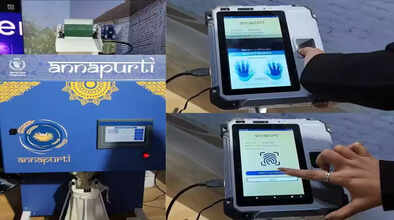Annapurti: 5G-powered grain ATM, now rations are available in a jiffy - learn how it works..

IMC 2025: At the Indian Mobile Congress 2025, Ericsson showcased another impressive "Made-in-India" device called "Annapurti." This is a 5G-enabled grain ATM developed in collaboration with the World Food Program. Imagine you no longer have to wait in long queues to get rations. Currently, you have to wait in line for hours, and it's late in the evening before your turn comes. But now, with this machine launched by the government, you can easily dispense rations in real time and in a short time.
Identification by Aadhaar, 30 kg of grain in 30 seconds!
This "Annapurti" device uses Aadhaar-based biometric scanning. This means that your identity will be verified by Aadhaar, ensuring complete transparency and eliminating irregularities in ration distribution. The company claims that this device can dispense 25 to 30 kg of grain in just 30 seconds. Currently, these are installed in Bhopal, Gorakhpur, Lucknow, Shillong, and Varanasi, and will be available in 23 more cities by the end of 2026.
Fiber-like speeds reach rural areas!
Andres Vincent (Head of Market Area Southeast Asia, Oceania, and India) of Ericsson reported that their Fixed Wireless Access (FWA) solution has acquired 8.4 million customers in the country. Its reach in rural areas is 40%. This means that even where fiber cables cannot reach, this wireless technology is providing fiber-like fast internet speeds. This is a major step towards digital empowerment of rural India.
Highlights of the Annapurna Grain ATM
Easy access for all: Any ration card holder in India, regardless of state or union territory, can get their entitled grain.
Fast and effective: This machine dispenses up to 50 kilograms of grain in just 5 minutes, reducing waiting time by 70%.
Dispensing a Variety of Grains: After biometric identification, this machine dispenses rice, wheat, and other grains with high accuracy.
Continuous and Uninterrupted Access: This ensures that beneficiaries receive their full ration without any human intervention.
Energy-Efficient and Modular: It is easily assembled and consumes very little power. There is also an option to install solar panels for automatic refilling.
How Does Odisha's First 'Rice ATM' Work?
The process of how the Annapurna Grain ATM works is described below:
Dispensing Process: This machine efficiently dispenses up to 50 kilograms of rice within 5 minutes, with an error rate of only 0.01%.
User Access: Beneficiaries enter their ration card number on the touchscreen, provide biometric identification (fingerprint or eye scanning), and upon successful identification, receive their allotted rice (up to 25 kilograms).
Benefits of the Annapurna Grain ATM
Reduced waiting time: It eliminates the long queues at traditional ration distribution centers.
Enhanced security: It reduces theft and black marketing in the food distribution system.
Improved accuracy and speed: It ensures accurate weighing and reduces waiting time by up to 70%.
24/7 availability: It allows beneficiaries to collect rice at any time.
Expansion and energy efficiency of the Annapurna Grain ATM
Initial launch: It was first launched in Bhubaneswar, and there are plans to expand it to all 30 districts of Odisha.
Future integration: A nationwide rollout is possible under the 'One Nation One Ration Card' scheme.
Energy-efficient design: It consumes only 0.6 watts of power per hour and supports solar panel connectivity for automatic refilling.
Easy installation: It is designed to be easily installed at various locations.
Additional Improvements and Enhancements
Removal of Fake Ration Cards: Over 1.6 million fake ration card holders have been identified and removed, ensuring that genuine beneficiaries are not impacted.
Aadhaar-based verification: e-KYC has been implemented to enhance transparency.
New Initiatives:
Separate ration cards for those separated from their parents' homes.
Home delivery services for senior citizens and persons with disabilities.
Special biometric solutions for beneficiaries with fingerprint recognition difficulties

